





Christmas is getting closer by the minute. The shopping frenzy is on. Every year, as a result of poorly thought out Christmas presents, several thousand dogs are abandoned or killed. Did you know that some shelters suspend animal adoption at Christmas time? Why? Because an animal is not a thing.

Think before you buy!
Any responsible, animal-loving person should know that a living being ought not to become a gift, and that wanting to have a pet can’t be just a short-lived whim. This is why the “Pies to nie prezent” campaign (a dog is not a present) is underway at many establishments such as foundations and shelters all over Poland.

It should be noted, however, that it’s not only dogs (most often puppies) that fall victim to human thoughtlessness – this also applies to cats, rabbits, hamsters, and other cute pets.
Many people don’t think about the bad, traumatic experiences of most animals in shelters. You mustn’t hurt them again by treating them like a thing and making a hasty decision to adopt. Such short-lived ‘want’ has its consequences, because after Christmas, when no one has time for them anymore, dogs return to shelters, are left in forests, or change hands again and again. Such a turn of events leaves a mark on their psyche forever, or ends in the worst scenario for them – death.
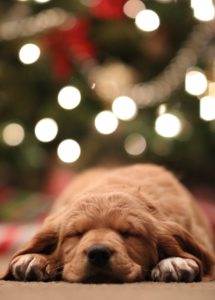
In turn, the animals at pet shops become victims of our social approach to consumerism. An animal becomes a gift, because we are able to buy it. By giving animals as ‘gifts’, we reduce them to objects supposed to please the recipient. It’s easy to forget that they’re living, feeling beings, and that the gift may simply turn out to be failed and unwanted. Because every animal is a responsibility.
Dear readers! On these important days, when we’re focused on beautiful feelings – love, peace, goodness – let’s remember that an animal is not a thing, an ‘object’, but rather someone who must be cared for and whose needs have to be tended to. A family member for many years.
Choosing a dog’s bed is very important! Not least because some dogs can sleep in their bed even 14 hours a day! Provided it’s a bed that they like… and your pet deserves the best!
Even a dog that loves sleeping in the same bed as you more than anything else, needs a quiet, safe haven to take naps and relax.
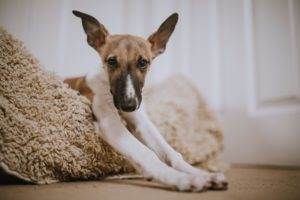
Choosing the right bed for your dog is not easy because of the extremely wide range of products available. It’s good to focus on quality – good fabrics and a decent sewing job – there are plenty of cheap beds on the market that won’t stand the test of time or your pet’s destructive tendencies. It may also turn out that your dog prefers sleeping on the floor.
QUALITY, QUALITY AND – ONCE AGAIN – QUALITY
Pay attention to the filling of the bed and cushion – good quality foam is most often the best choice. With some beds, it’s even possible to take the cover off, which makes cleaning and washing much easier. Owners of rascals (but not only!) may be interested in beds made of waterproof and quick-drying materials (some of you probably already know very well what smell is given off by wet dog hair at home…).
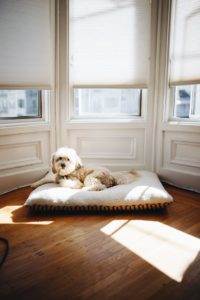
WHAT KIND OF BED DOES YOUR DOG DREAM OF?
The bed should be individually matched to each dog.
If your dog likes to stretch and push – try a cushion or a pontoon-like bed. In the Comfy range, you’ll find one, e.g., under the name of ARNOLD PILLOW.
Or maybe your darling prefers to curl up in a ball while sleeping? If this is the case, then the ideal solution for it will be a bed with cosy sides. For example, TEDDY, EMMA PLUSH, or PATI PLUSH.
To owners of insane Labradors, mud bath enthusiasts, or ‘slightly’ hyperactive quadrupeds of all breeds, we recommend the durable and comfortable ARNOLD PONTON MELANGE bed.
SIZE MATTERS
The right size of the bed is of key importance. You can choose whatever style of the bed you like, but remember that, just like people, dogs too have their habits – take a look at your pet while it’s resting.
Before making a purchase, apart from observing your pet, it’s a good idea to measure it from its snout to the base of its tail, and from the top of its head to the ends of its paws. When choosing the size of the bed, add a few extra centimetres so that you can be sure the bed for your dog isn’t too small.
TOP 4 HINTS
When choosing a bed, consider these 4 important factors:
Solid workmanship – it’s better to spend a few more quid just to be sure that the bed won’t fall apart after a few weeks.
Fabric – choose one that’s easy to clean, resistant to dog claws, but also pleasant to the touch.
Type of bed – a simple mattress or one with walls? Or maybe a kennel? The choice is very wide. Watch your dog while it rests, and choose the bed that suits its preferences.
Size and fit – before buying the bed, measure your pet. It’s always better when it’s a little too big rather than too small.
If you love dogs, sooner or later you might have the idea that if one is so great, then two will be even better! Two playful silly furballs will keep you entertained. They’ll keep each other company when they’re alone. And you, in your spare time, the proud master of the beasts, will show them around. No boredom!
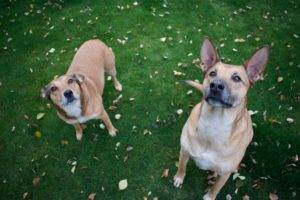
But hey, master of the beasts, wait a second. Bringing harmony to the herd is a delicate task. And your anguish will be endless if you make mistakes.
Two dogs = a lot more time and attention
It’s obvious that a new dog in the house will require a lot of your attention at first, so that you can form a tie with the new member of the family. Meanwhile, you can’t neglect your first dog. Try to treat it in the same way as before – remember that until now it was the favourite. Set clear rules and consistently enforce them on both dogs.
The dogs must not be left unattended. Both dogs will need time to get used to each other. Remember: nothing can be accomplished by force!
You’ll be really surprised – at least in the first few months – how much time it takes you to make sure there are no squabbles over toys, food, trash, the bed, or… people 🙂
Think how much time your pet needs from you now. Then multiply this by three. For real! Is this truly something you can handle?
To begin with, solve the behavioural problems of your first dog
“My dog is driving me crazy. It’s always barking, howling, kicking, destroying things. I hope that when it has a friend, it’ll stop doing these things”.

This plan is like crossing a busy street blindfolded. Of course, there is a chance that you’ll get lucky and do just fine… but do you really want to risk it?
In most cases, dogs acquire bad habits from each other.
If your first dog goes crazy at the sound of the doorbell, then the new dog will soon learn that too. If your dog steals food from the table, its new buddy will think it’s a WONDERFUL idea too.
Consider not only the character of your dog, but also its behavioural problems and past. You shouldn’t decide to have another dog in the house if you’ve observed the following traits in the ‘resident dog’:
• a tendency to defend objects,
• jealousy (e.g. when you pet or feed another dog),
• aggressive behaviour, particularly that directed towards other dogs,
• fear of dogs that it’s never met before.
Sign your dog up for training, teach it discipline, make it a great role model for a new family member.
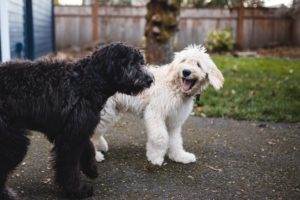
Choose the right dog
What to consider?
• Degree of liveliness – most dogs get on well with dogs that display a similar degree of liveliness or have a similar disposition. A gentle dog is likely to make friends with another gentle canine. But this is not always the case. Sometimes, a very calm, withdrawn dog is prone to ‘come out of its shell’ in the company of a more energetic, cheerful dog.
• Age – if you have a 13-year-old senior suffering from arthritis, a crazy puppy is likely to drive it mad. For an older dog, a more suitable companion will be a mature, 3- or 5-year-old individual.
And if you have a noisy 1-year-old wacko, there is a great chance that another noisy ‘teenager’ will give you a severe headache 🙂
• Gender – in principle, you should choose the gender opposite to that of your current resident dog. Then you won’t have to deal with such fierce competition for various objects or territory. However, this rule is very general and there are many exceptions to it.
CHECK WHAT DOG IS YOUR DOG’S TYPE
If you don’t know what type of dog to choose, ask your dog about it. It’s easy!
On a walk, while your dog’s socializing with others, pay attention to what dogs it feels most comfortable with, and which ones it enjoys playing with the most. And which ones it avoids.

How to introduce two dogs?
Learn to read the animal’s body language. A dog sends you a lot of signals! Much more than just wagging its tail, barking, or growling. You don’t want to miss any.
Hold the leash as loosely as you can. People instinctively keep leashes short in such situations, and this is a mistake. It forces the dog to hold its head high, and, in the dog world, that is a sign of aggression or taking a dominant position. Besides, this simply annoys other dogs. A bad mood all around you! Not the best way to make a new friend.
Approach at an angle – don’t go to the other dog head-on, like a tank. Ideally, you and your ‘assistant’ should meet at the point of the letter V.
The dogs will start to sniff each other under the tail. Let them do so. It’s the normal, customary greeting in the dog world. Meanwhile, make sure their leashes don’t get tangled. If the dogs are relaxed and calm, you can let them sniff each other for up to 30 seconds.
If any tensions arise, gently pull your dog aside, take it some distance away, and, after a few minutes, come back and repeat everything from the beginning. You may have to do this several times.
If the dogs don’t want to play with each other, don’t force them to.
After the ‘first steps’ have been made and the dogs have gotten to know each other, go for a walk together.
Bringing the second dog into the house
The decision has been made! The papers are signed! You’ve become the owner of another quadruped. Take both doggies to a neutral place near your home, from where you’ll all be able to go home together.
A walk before entering the house brings the dogs closer, gives them a chance to relax in each other’s company.
Before you bring your new dog into the house, hide all the toys and bowls of the resident dog. This is its property and it may want to protect it by threateningly baring its teeth. Also, keep the new dog away from the bed of dog number 1. And just in case – if you have children – keep them away as well, should there be any squabbles between the two furry household members.
The next step is to feed the two beasts to build further positive associations and relations between them. Separate the dogs from each other – keep them far apart enough for them not to defend their bowls, but close enough for them to sense each other’s presence.
After eating, it’s time to play
Over the next few days, make sure that toys aren’t scattered on the floor – they may trigger territorial fights. Watch your pets. Never leave them unattended until you’re sure they’ve fully accepted each other and are in no way competing.
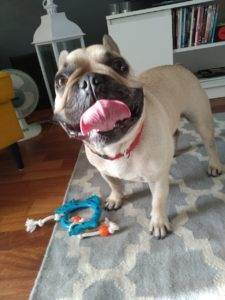
If you don’t want your dog to go crazy, you must provide it with the right exercise, not only for the body, but also for the mind!
Most dogs are working animals. Even if at home you have a spoiled furball that lies on the floor and sniffs at the tips of its paw pads all day long, it’s still descended from a long line of cunning, hard-working animals that had to fight and conquer in order to survive.
Lock your pet in the backyard, limit its freedom to sniff things, explore, figure things out, or overcome various obstacles, and – sooner or later – it’ll go mad! What are the symptoms? Ceaseless barking, escaping, obsessive kicking, destructive chewing, compulsive chasing of its own tail, and so on…
If you want your dog to behave, you have to exercise with it. But this is only the halfway to success. It’s not enough to put a bored dog on a treadmill for an hour and let it run itself ragged. What will be the result? An extremely bored dog in good shape.
You want your ‘Max’ to stop being a pain in the…? Then force his mind to make an effort.
This is where the so-called ‘interactive’ toys come into your life 🙂 These include various gadgets that you can fill with food and then watch your pooch try to get to it. Sounds like torture? Nothing of the sort. It forces your dog to THINK about what it’s doing here and now, instead of mindlessly emptying the bowl or being given treats ‘for nothing’.
CLASSICS: Plug & Play Snacks
Every dog should have at least a few of these in its toy basket. The Comfy Plug & Play Snack series is a unique combination of fun and treats. The Comfy toys, supplemented with a Plug Snack, provide great and long-lasting fun for every dog. They come in three delicious flavors: chicken, beef, and salmon.
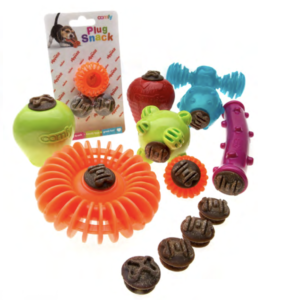

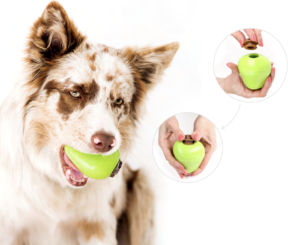
Exceptionally durable toys made of thermoplastic elastomers (TPE), designed for active dogs with strong jaws. Compatible with the treats from the Plug Snack line.


A toy and treat dispenser in one. Indestructible. All dogs love it. A must-have in every house with dogs.
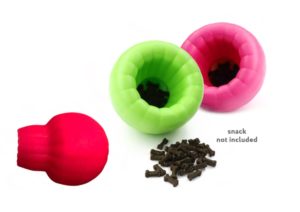
Mint Dental Rugby and Mint Dental Stick
Colorful dog toys made of thermoplastic elastomers (TPE). They clean and massage the gums, are unsinkable, and smell like mint. Compatible with the treats from the Plug Snack line.
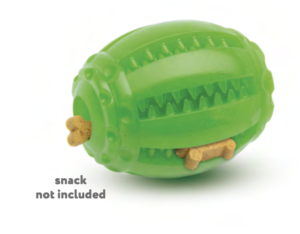

‘Board games’
These require the greatest intellectual effort from your dog. Dogs really need to use all their skills to understand what these are all about 🙂
It’s best to start with basic logic toys, and only then move on to the more difficult ones. Note: with these types of toys, your dog shouldn’t be left unattended, because they have a lot of small, moving parts that your ‘Max’ may accidentally devour.

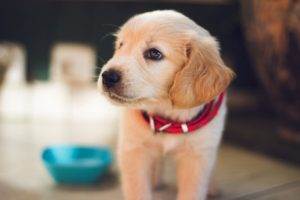
The cute pup is arriving in its new home in a few days. Wondering if you’re well prepared for the frolicky little rascal?
To make it easier to read, the list has been divided into things that are ‘indispensable’, things that are ‘good to have’, and things that you can do without.
INDISPENSABLE
DOG CRATE
Unfortunately, many people still have negative associations with a crate, and that’s a pity because it’s something that helps to establish clear rules for your puppy. From the very beginning, it teaches the pup to calm down and rest, and it’s an additional advantage for you if you have problems connected with furniture damage, separation, or control of peeing and pooping. By properly using a crate and observing the puppy’s behavior, you can more quickly eliminate the ‘flooding’ of the house floor 😉 This is especially useful at night, when it gives you a chance to quickly take your puppy out for its first morning walk before it ‘goes to the toilet’ in a more secluded part of the apartment.
GOOD CHOW IS ESSENTIAL
Proper nutrition of a pup in its ‘adolescence’ is key. This is why it’s important to think about buying good quality dry food intended for puppies. If your pup comes from a breeding establishment, then it’s a good idea to buy the same food as the one that the breeder fed it with, so as to avoid any stomach upsets. If necessary, you can gradually accustom it to different food over a period of 1–2 weeks. Also, it’ll be good to have a few cans of wet food, which works great as treats in toys specially designed for this purpose (the Plug Snack series by Comfy).
TRAINING TREATS
Each piece should be the size of a pea. If you want to prepare a ‘homemade’ treat, then boiled chicken chopped into tiny pieces will be perfect. It’s inexpensive, nutritious, and can hold your puppy’s attention really well. Some other great delicacies are the Comfy Meat Bliss – natural meat strips perfect as a dog snack or reward on a walk or in training. They’re easy to divide into smaller pieces, so they last for a long time and are suitable for dogs of all breeds and sizes.

‘THE ONES THAT MAKE SMACKING SOUNDS’
Those are the famous toys ‘with holes’ designed to be filled with food. They can replace a traditional bowl and be used to serve food to your puppy. This keeps it busy for many hours, and away from trouble. Its little brain works hard and exercises, and you… well, you can enjoy peace and quiet for a while. It’s best to buy one or even two rubber chew toys from the Plug Snack series.
CHEW TOYS
Puppies love to chew. Very much and very often 🙂 Give them enough toys to chew, and they’ll leave your shoes (or something more valuable) alone. Comfy Elka – durable toys designed specially for chewing and biting – will be a perfect choice. Avoid chew toys made of rawhide. They are difficult to digest and may cause bowel obstruction which, in turn, requires a surgical intervention.
SQUEAKY AND PLUSH TOYS
It’s best to get a whole stock of these in various shapes and sizes, and change them every few days. Your puppy will bite and damage them – good! This is what toys are for when you’re a dog. Just remember to check for and tidy up any torn off toy pieces so that your little destroyer doesn’t choke on them. A perfect choice will be, for example, the absolutely lovely, cute animals from the Slimmy, Farm, and Fatty series by Comfy.
TRAINING PADS
You’re going to need these. A lot 🙂 They help to protect the floor, the upholstery of the sofa, and the car seats from getting soiled with you know what. You’ll find pads (of various types) in our store too 😉 Comfy Paddie Ultra – five-layer pads with ultra-absorbent granules as well as the fungicidal and bactericidal extract of the leaves of the Camellia Sinensis (green tea) plant.

THE RIGHT CLEANING PRODUCT
It must be an enzymatic liquid specially designed to remove the smell of urine. Your puppy must not be able to smell it, otherwise it’ll pee again in exactly the same place.
COLLAR/HARNESS
Adjustable, made of nylon or cotton (e.g. Comfy Dotty or Multi, Meg – all of which come complete with a leash). You’ll be able to adjust it to the neck of the rapidly growing pup. After you’re done, it should be possible to insert two fingers under the collar. A harness will be even better. It’ll help to avoid jerking the pet’s neck (highly inadvisable!) when the owner’s trying to ‘correct’ its behavior or when the quadruped itself makes some unexpected, abrupt moves.
LEASH
Made of cotton, nylon, or leather. With a length of about 1.5–2 meters. Don’t buy leashes in supermarkets. It’s worth investing in a better quality product to be sure you have your wacko under control.
FOOD AND WATER BOWLS
The size of the bowls should correspond to the size of the pet. Pups must be able to eat and drink from them with ease. For puppies, 0.3l bowls on non-slip feet will be suitable, for example, Comfy Smart Clean (with a mat that makes it easier to clean after they’re done eating) or Ceramic Space (made of natural materials, and very stable).
WASTE BAGS
Indispensable when conquering the world and going on adventures. The best ones will be those that are durable and tear-resistant, such as George and Georgia + (possibly) a scoop.
GOOD TO HAVE
Things which are not indispensable if you’re on a tight budget, but which – if you can afford them – might make your life much easier.
SAFETY GATE/BARRIER
After you install one, you won’t be able to imagine your life without it. It’s ideal for setting the boundaries, securing the places that are to be inaccessible to the quadruped, and, also, it protects the pet against falling down the stairs.
LONG TRAINING LEASH
With a length of about 6 meters, or maybe even 10–20 meters, depending on your puppy’s age. Ideally suited for teaching the dog to come to the owner when called.
POUCH FOR TREATS
Makes training much easier – it’s practical and handy.
BITTER APPLE SPRAY
It tastes terrible, so you spray it on surfaces such as furniture corners, chair arms, or baseboards.
CAN DO WITHOUT
EXPENSIVE CAGES AND BEDS
In its bed, your little ‘wonder’ usually chews on something, pees, or burps something up. So, it’s a good idea to put off buying the ultimate bed until your doggy grows up and becomes less destructive. To pad the cage or make a provisional bed, you can use old blankets, towels, etc.
AUTOMATIC LEASH
These can be dangerous to both people and pets. They make it harder to control an uncoordinated pup, they get tangled, make instant reactions impossible (e.g. drawing your puppy in), and they can wrap around its body and hurt it.
Check where you can buy
our products
Map of stores